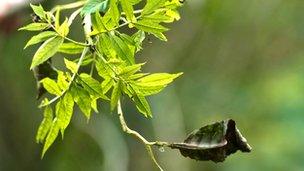Ash genome reveals fungus resistance
- Published

Scientists have sequenced the genome of a type of ash tree with resistance to the deadly fungal disease sweeping the UK.
The development could be the starting point for breeding a strain of ash to replace thousands expected to succumb to ash die-back in the next few years.
Ash die-back is now established and spreading within Britain
Researchers are hoping that genetics might yield the knowledge to fight back.
A joint project by the John Innes Centre, the Genome Analysis Centre and the Sainsbury Laboratory - all based in Norwich - has reached this milestone just two months after receiving the samples.
Dr Mario Caccamo of the Genome Analysis Centre said: "Speed is important to the research so that all those studying the epidemic can start to look for clues to tackle it."
And they do mean everyone.
All the data is being put on a crowd sourcing website OpenAshDieBack to enable experts from around the world to help identify genes that might be connected to the trees' ability to withstand the fungus.
These genes could then be part of a breeding programme for resistant trees.
The samples for the latest research came from so-called "tree 35", a strain of ash from Denmark originally bred nearly 100 years ago, which has shown an ability to tolerate the fungal disease, when virtually all its Danish relatives were wiped out.
But just planting this variety in the UK would leave us with a narrow genetic base vulnerable to future diseases and not ideally suited to British growing conditions.
Prof Allan Downie of the John Innes Centre believes this genetic understanding of both the lethal fungal infection and the surviving strain could help fill the impending gap in the canopy.
"We're trying to give nature a bit of a helping hand by identifying the right kind of (native) trees to do the appropriate crosses," he said.
"It would be wonderful to be part of the solution but the problem is enormous and the breeding is going to take a long time."
In March, a related team sequenced the genome of the fungus that causes die-back.
The firm grip of this disease is evident in many of East Anglia's woodlands.
While filming with Countryfile in Suffolk, Paul Beales from Fera, the government's Food and Environment Research Agency, set up a search for the Chalara fraxinea fungus itself.
The symptoms of the disease were plain to see in scars on the trunk and skeletal canopies, but the source of the infection - the sporulating fungus - had not been found in Britain.
After half an hour on hands and knees in the leaf litter and some identification first by magnifying glass and then by genetic analyser, that all changed.
Paul Beales said: "We've just got the sporing stage of this particular fungus picked up from the ground which has never been found in the UK before. "This is a first. It's here to stay."
If that is true, breeding a tree which can survive alongside it is more crucial than ever.
Countryfile is broadcast at 1900 BST on BBC One.
- Published12 June 2013
- Published8 March 2013